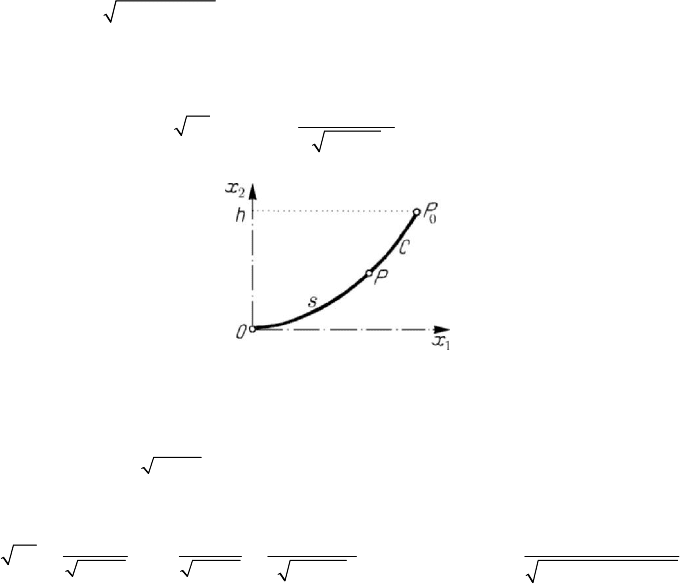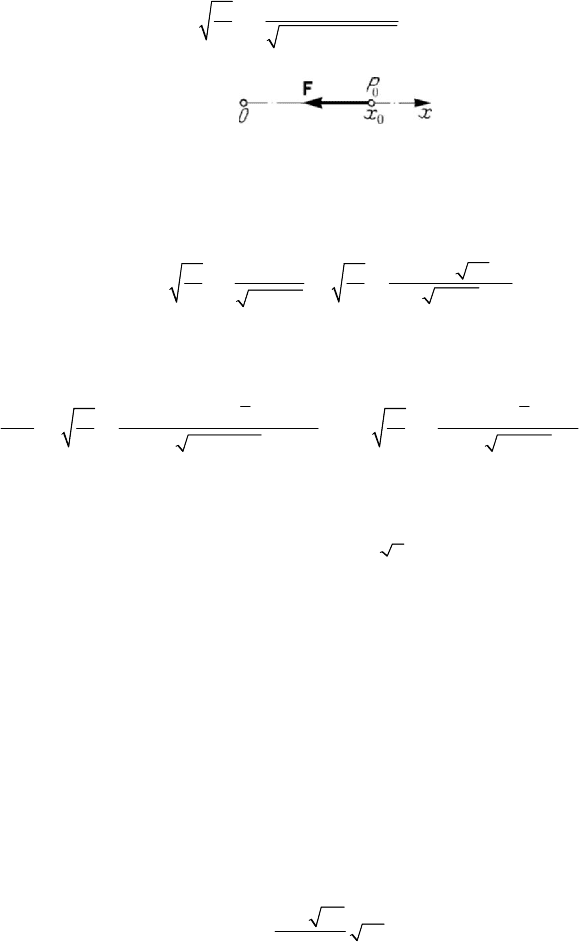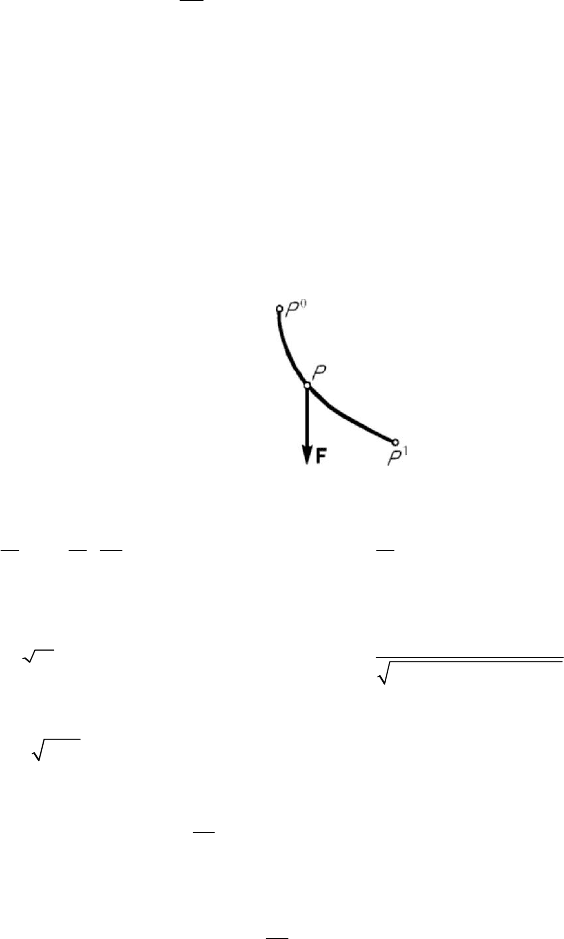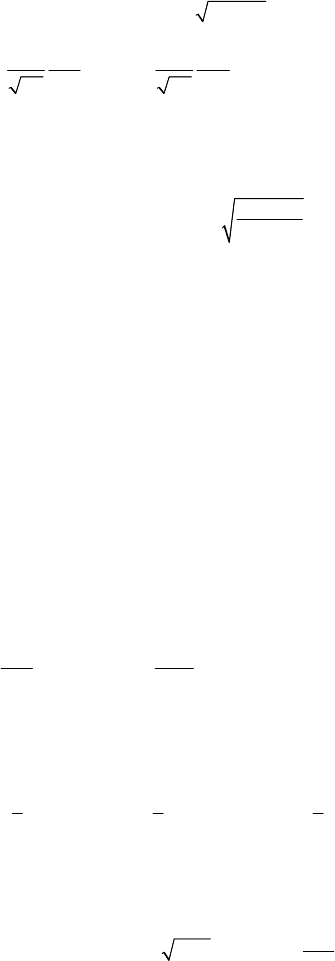Teodorescu P.P. Mechanical Systems, Classical Models Volume I: Particle Mechanics
Подождите немного. Документ загружается.


Problems of dynamics of the particle
441
2.1 Tautochronous motions. Motions on a brachistochrone and on a
geodesic curve
In what follows, after presenting the problems of Abel and Puiseux, one considers –
in particular – the study of tautochronous motions. A particular attention is paid to the
motion on a brachistochrone curve or on a geodesic one, the study of which needs some
notions of variational calculus.
2.1.1 Abel’s problem
N.H. Abel tried to determine a curve
C , contained in a vertical plane and passing
through a given fixed point
O , so that a heavy particle P , which is moving without
friction on this curve, starting from the point
0
P , situated at an applicate h above the
point
O , reaches that point, without initial velocity, in an interval of time ()hττ= ,
[
]
0,ha∈ , assuming that the continuous function τ is given. We choose the
horizontal as
1
Ox
-axis, the
2
Ox
-axis being the local ascendent vertical (Fig.7.16); the
curve
C is specified by the equation
(
)
2
sxϕ
=
, (0) 0ϕ
=
,
[]
1
0,Caϕ ∈
, where s
is the curvilinear abscissa. The conservation theorem of mechanical energy gives
()
22
2
(d /d ) 2vstghx==−. Noting that ()st is a decreasing function, we may
write
()
222
d2 d()dsghxtxxϕ
′
=− − = ; by integration (
2
xh
=
for 0t = and
2
0x = for t τ= ), we obtain an integral equation of the first kind, with a variable
superior limit
(
)
22
0
2
d
2()
h
xx
gh
hx
ϕ
τ
′
=
−
∫
.
(7.2.1)
Figure 7.16. Abel’s problem.
To solve this integral equation, which is the first one appeared in mathematical
analysis, we use a particular ingenious procedure due to Abel; we multiply both
members by
d/huh− ,
[
]
0,ua
∈
and integrate with respect to
h
between the
limits
0
and u , so that
()
2
22
22
000 0
2
2
()d ( )d
dd
2()d
()
uuh uu
x
hh x x
hh
gxx
uh uh hx
uhhx
τϕ
ϕ
′
′
==
−−−
−−
∫∫∫ ∫∫
,

MECHANICAL SYSTEMS, CLASSICAL MODELS
442
where the order of integration has been inverted (in fact, a double integral on a
triangular domain bounded by the lines
2
0x
=
,
2
xh
=
and hu
=
is calculated).
Noting that the latter integral is equal to
π , one obtains, finally,
()
()
2
2
0
2
2d
x
ghh
x
xh
τ
ϕ
π
=
−
∫
,
[
]
2
0,xa
∈
.
(7.2.1')
Following these ideas, Euler and Saladini deal with the determination of a curve
C
in a vertical plane, so that a heavy particle
P , which is moving without friction on this
curve, departing from the point
0
P , without initial velocity, reaches an arbitrary point
P in the same interval of time as that necessary if the particle would slide along the
bisecant
0
PP, finding thus a lemniscate. O. Bonnet showed that this lemniscate has
further the above mentioned property if we replace the gravitational field by a field of
central forces of attraction, proportional to the distance to the pole
0
P . As well, Fouret
considers a particle which is subjected to the action of a field of conservative forces in a
plane and which departs from the position
O without initial velocity; a problem to
determinate a family of homothetic curves
C passing through O , so that the particle
which departs from this pole describes an arc of curve
C till the point P in the same
interval of time in which the corresponding bisecant
OP would be travelled through is
put. The problem has a solution if the potential function is of the form
2
(, ) ( / ()) ()Ur rθψϕθϕθ= in polar co-ordinates, ϕ and ψ being arbitrary functions
of class
1
C ; the equation of the curve
C
is, in this case, of the form
()
d
22
()
()erk
ϕθ
θ
ϕθ
ϕθ
−
′
∫
=
, constk
=
.
(7.2.2)
Analogously, one may put the problem to determine the field of conservative forces
which act upon a particle the trajectory of which is a curve from the family of curves
C
previously considered; if the equation of the curve
C
is of the form ()rkωθ= ,
constk =
, then the potential function is of the above mentioned form, where
[]
2
()/ () 1d
() ()e
ωθ ωθ θ
ϕθ ωθ
′
−+
∫
=
.
(7.2.2')
2.1.2 Puiseux’s problem
In connection with tautochronous motions we consider – first of all – a particular
problem, put and solved by Puiseux. It is thus asked to determine a law of force
()FFx= for which a rectilinear and frictionless motion is tautochronous with respect
to the pole
O
of the trajectory (Fig.7.17). The conservation theorem of mechanical
energy leads to
[
]
2
0
2() ()mx x xψψ=−
where we denoted by
0
() ()d
x
xFψξξ=−
∫
, (0) 0ψ
=
,

Problems of dynamics of the particle
443
an increasing positive function, because
()Fx is a function obviously negative for
0x > , if we assume that
0
0x > (the force must be directed towards the pole O ,
because the particle must move towards that point). The particle reaches the point
O in
an interval of time equal to
0
0
0
0
d
2
() ()
x
mx
xx
τ
ψψ
=
−
∫
.
(7.2.3)
Figure 7.17. Puiseux’s problem.
If we denote
()xzψ = ,
00
()xzψ
=
,
0
zzu
=
and ()xzχ
=
, where χ is the inverse
function, it results
0
1
00
0
00
0
()d ( ) d
22
1
z
zz zu zu
mm
zz
u
χχ
τ
′
′
==
−
−
∫∫
;
the condition that
0
τ be not dependent on
0
x , hence on
0
z , is put in the form
0
00 0
1
0
00
000 00
11
() () () ()
d
22
dd0
d2 2
z
zuzu zu z z z
mm
uz
zzzu zzz
χχ χχ
τ
′′ ′ ′′ ′
++
===
−−
∫∫
for any
0
z , so that we must have 2() ()0zz zχχ
′
′′
+
= (otherwise we may choose a
0
z sufficiently small so that the integrand be of a constant sign, so that the condition
would no more be fulfilled). We get
() 2zczχ
=
,
constc
=
, an additive constant
being equal to zero, because
z and ()xzχ
=
vanish simultaneously; it results
22
() /4zxxcψ==
, so that
2
() /2Fxxcψ
′
=− =−
. We see thus that the only force
()FFx= which leads to a tautochronous rectilinear motion is a force in direct
proportion to the distance (which will be studied in Chap. 8, Subsec. 2.2.1).
If the resultant of the given forces depends on the position as well as on the velocity,
the problem is more intricate. Lagrange gave a law for the force for which the
tautochronism takes place and from which – if the velocity is no more involved – one
obtains the previous results. But this law does not contain all possible cases; e.g.,
Brioschi gave a more general formula.
2.1.3 Tautochronous motions
If we make
0
() consthττ== in the formula (7.2.1'), then we obtain
0
22
22
()
g
sx x
τ
ϕ
π
==
,
(7.2.4)

MECHANICAL SYSTEMS, CLASSICAL MODELS
444
denoting
22
0
/gaτπ= , we find again the equation of the cycloid (Fig.7.12), considered
in Subsec. 1.3.5. We have seen that the cycloid is a tautochronous curve, the respective
motion being a tautochronous one with respect to the point of tautochronism
O , which
is reached by the particle, acted upon by its own weight, in the same interval of time
0
τ , independent of the initial position, if the initial velocity vanishes. Besides, the
cycloid is the only tautochronous curve with respect to a gravitational field.
In general, we say that a motion (hence, a curve
C ) is tautochronous if there exists a
point
O
′
(called point of tautochronism) on this curve, so that a particle which is acted
upon by given forces of resultant
F and which, departing from the position
0
P ,
frictionless and without initial velocity, reaches the position
O
′
in an interval of time
independent of
0
P . Projecting the equation of motion on the tangent to the curve, we
may write
2
2
d
d
()
d
d
i
t
i
x
s
mFF fs
s
t
== =
,
(7.2.5)
where the second member is function only on the curvilinear co-ordinate
s , if we
assume that the resultant of the given forces depends only on the position (
()=FFr).
The equation (7.2.5) is identical with the equation of the rectilinear motion on the
Os -
axis, if the particle is subjected to the action of a tangential force
t
F .
Taking into account the results obtained in the preceding subsection, we must have
2
()
f
sks=− , so that the trajectory C be tautochronous, that one being a necessary
and sufficient condition; the point of tautochronism
0s
=
is – obviously – a stable
position of equilibrium. The solution of the problem is indeterminate, to determine it
being necessary a supplementary condition. For instance, one may put the condition that
the curve
C lays on a given fixed surface
(
)
123
,, 0xxx
=
F , adding the obvious
relation
2
dd d
ii
xx s= ; one may obtain thus the parametric equations of the trajectory
()
ii
xxs= ,
1, 2, 3i =
, introducing two new constants of integration besides
2
k
. In the
case of a conservative force, we obtain easily
()
2
2
123
,,
2
k
Ux x x s K
=
−+, constK
=
.
(7.2.6)
As well, we may put other conditions, e.g., that the curve
C be tautochronous, with the
same point of tautochronism for other given forces of resultant
′
F ; we introduce thus a
new condition of the form
2
d
d
i
i
x
Fks
s
′′
=−
, constk
′
=
.
(7.2.5')
Hence, the curve obtained is tautochronous for a force
λλ
′
′
+
FF, λ , λ
′
constant
positive scalars. If the second force is conservative too, of potential

Problems of dynamics of the particle
445
()
2
2
123
,,
2
k
Uxxx s K
′
′′
=− +
, constK
′
=
,
(7.2.6')
the tautochronous curve will stay on the surface
()
[]
()
[]
22
123 123
,, ,,kUxxx K kUxxx K
′
′′
−= −
.
(7.2.7)
In the general case of a resistent medium of resistance
()Rv
=
, the resultant of
the given forces depending also on the velocity (
(, )
=
FFrv), the equation of motion
reads
(
)
2
2
d
dd
dd
d
i
i
x
ss
mF
st
t
=+
;
(7.2.5'')
we come thus back to the previous case of rectilinear motion for which a necessary and
sufficient condition of tautochronism is not known, being possible to use – in particular
– the law of force given by Lagrange.
2.1.4 Considerations on variational calculus
To study the motion on a brachistochrone, there are necessary some results
concerning variational calculus. Let thus be an integral of the form
1
0
() (;, )d
x
x
Iy Fxyy x
′
≡
∫
,
(7.2.8)
where
(;, )Fxyy
′
is a known real function of arguments
,xy
and d/dyyx
′
≡ , of
class
2
C
with respect to these arguments; the value of this integral depends on how is
chosen the function
()yyx= , wherefrom the notation used, as well as the
denomination of functional. We assume that the admissible arguments
()yx are of
class
2
C and that, at the extremities of the interval
[
]
0
1
,xx , they take the given values
0
1
,yy; in this case, the set
{
}
()yx of the admissible arguments ()yx may be seen as a
family of smooth curves, passing through the points
00
(,)xy and
11
(,)xy of which we
must choose one, which minimizes the functional
()Iy. A necessary condition to
determine this curve is the Euler-Poisson equation
d
0
d
y
y
F
F
x
′
−
= ,
(7.2.8')
associated to the variational problem
() minIy
=
, where
y
F and
y
F
′
, represent the
partial derivatives with respect to the corresponding arguments; developing, one obtains
2
2
dd
0
d
d
y
yy yy yx
yy
FFFF
x
x
′′ ′ ′
+
+−=.
(7.2.8'')
MECHANICAL SYSTEMS, CLASSICAL MODELS
446
If the condition (7.2.8') or (7.2.8'') holds, we say that the functional is stationary on the
curve
()yx . Because this condition is only necessary, one must then verify if the
solution of the respective differential equation minimizes effectively the functional
()Iy.
Let be now a functional of the form
12 12 1 2
() ( , ;, , )d d
D
Iu Fx x uu u x x≡
∫∫
(7.2.9)
on a set
{
}
12
(, )ux x of functions of class
2
C , which take continuously given values on
the frontier of the domain
D ; F is a given function of class
2
C in the arguments
12
,,xxu,
11
/uux≡∂ ∂ ,
22
/uux
≡
∂∂ on the domain of definition of those
arguments. The Euler-Ostrogradskiĭ equation corresponding to the problem of
minimum reads
(
)
(
)
12
,1 ,2
0
uu u
FF F−− =
,
(7.2.9')
being a necessary condition too. In particular, in the case of the functional
22
12 12 12
() 2( , ) d d
D
Iu u u fx x u x x≡++
⎡⎤
⎣⎦
∫∫
(7.2.10)
we find an effective minimum given by Poisson’s equation
12 12
(, ) (, )ux x fx xΔ=
(7.2.10')
on the domain
D .
Analogously, the functional
1 2 1 2 11 12 22 1 2
() ( , ;, , , , , )d d
D
Iu Fx x uu u u u u x x≡
∫∫
(7.2.11)
leads to the Euler-Ostrogradskiĭ equation
(
)
(
)
(
)
(
)
(
)
1 2 11 12 22
,1 ,2 ,11 ,12 ,22
0
uu u u u u
FF F F F F−−+ + + =
.
(7.2.11')
As well, for the functional
123 12 3 1 2 3
() ( , , ;, , , )d d d
D
Iu Fx x x uu u u x x x≡
∫∫∫
,
(7.2.12)
defined on a three-dimensional domain, we obtain the Euler-Ostrogradskiĭ equation
(
)
(
)
(
)
12 3
,1 ,2 ,3
0
uu u u
FF F F−−− =
.
(7.2.12')
In the case of several functions
()
k
yx, 1,2,...,kn
=
, of the same independent
variable
x , the functional

Problems of dynamics of the particle
447
1
0
12 12 12
( , ,..., ) ( ; , ,..., , , ,..., )d
x
nnn
x
Iyyy Fxyyyyyyx
′′ ′
≡
∫
(7.2.13)
leads to the Euler-Lagrange system of equations
()
d
0
d
k
k
y
y
FF
x
′
−=
, 1,2,...,kn
=
,
(7.2.13')
which represent necessary conditions of stationarity.
2.1.5 Motion on a brachistochrone
The problem to determine a curve
C passing through the points
0
P and
1
P is put,
so that a particle
P , which departs from
0
P with an initial velocity
0
v and is subjected
to the action of a field of conservative forces
gradFU
=
, does slide frictionless along
the curve from
0
P
to
1
P
in a minimal interval of time (Fig.7.18); a curve C which has
this property is a brachistochrone curve for the field of given forces. The conservation
theorem of mechanical energy leads to
Figure 7.18. Motion of a particle on a brachistochrone.
(
)
2
2
123
d
(, , )
22d
mms
vUxxxh
t
== +
,
2 000
0
123
(,, )
2
m
h v Uxxx=−
,
(7.2.14)
wherefrom
1
0
123
(,, )d
P
P
tm xxxsϕ=
∫
,
[]
123
123
1
(,, )
2(,,)
xxx
Ux x x h
ϕ =
+
;
(7.2.14')
noting that
()sϕϕ= , by the agency of the functions ()
ii
xxs
=
, 1, 2, 3i
=
, and that
dd
ii
sxxs
′
′
=
, d/d
ii
xxs
′
= , we may write the Euler-Lagrange stationarity condition
(7.2.13') in the form
()
,
d
0
d
ii
x
s
ϕϕ
′
−=
, 1, 2, 3i
=
.
(7.2.15)
Vectorially, we have
d
grad ( )
ds
ϕϕ
−
= 0τ ,
(7.2.15')

MECHANICAL SYSTEMS, CLASSICAL MODELS
448
where
d/ds= rτ is the unit vector of the tangent to the curve. It results
d
grad
ds
ϕϕ
ϕ
ρ
−
−=0τν,
(7.2.15'')
where we took into account the first Frenet formula,
1/ρ being the curvature of the
curve, while ν is the principal normal; a scalar multiplication by
τ
leads to the identity
grad d / d d / d 0ssϕϕ⋅− =r , so that the equations (7.2.15)-(7.2.15'') are reduced to
only two equations.
We notice that the equation (7.2.15') is of the same form as the equation of
equilibrium (4.2.57) of a perfectly flexible, torsionable and inextensible thread, where
ϕ=T τ , T ϕ= being the tension in the thread, while () grads ϕ
=
−p is the external
conservative load on the unit length, which acts upon the thread, corresponding to the
formula (4.2.58'); as well, the equations (7.2.15) may be put in correspondence with the
equations (4.2.59). Taking into account (7.2.14'), it results
3
,,ii
Uϕϕ=− , 1, 2, 3i = , so
that
33
( ) grad gradsUϕϕ ϕ=− = =pF, where F is the given force which acts
upon the particle in motion on a brachistochrone. Projecting on the principal normal to
the curve
C
, one obtains
3
//pFT
νν
ϕρϕρ==−=−, wherefrom
2
1/F
ν
ϕρ=− ,
relation which gives the curvature of the brachistochrone as a function of the given
force which acts upon the particle. From (7.2.14), one may write
22
1/mv ϕ=
; on the
other hand, the equation of motion in intrinsic co-ordinates reads
2
/mv F R
νν
ρ =+,
where
R is the constraint force which acts upon the particle constrained to stay on the
curve
C , which must be determined. There results
2
1/FR
νν
ρϕ+= , so that
2
2/N
ν
ρϕ= and
2NF
νν
=
− ; (7.2.16)
we may state
Theorem 7.2.1 (Euler). In the motion on a brachistochrone, the modulus of the normal
constraint force is twice greater than the modulus of the normal component of the
resultant of the given forces.
If
constT ϕ== along the thread, we may suppose that one stays on a smooth
surface
constϕ
=
(equipotential surface), ()sp being a constraint force ()sR ; in this
case, the unit vector ν coincides with the unit vector
n of the normal to the surface
and the brachistochrone is a geodesic curve of the surface. Noting that, in this case,
3
() ()ssϕ=RF
, it results that such a situation is obtained only if the field of given
forces is normal to the searched brachistochrone at each point of it. From this point of
view, we may search such curves, situated on a surface and corresponding to a field of
given conservative forces. The equation (7.2.15') reads
d
grad grad ( )
d
f
s
ϕλ ϕ
+
−=0τ ,
(7.2.17)

Problems of dynamics of the particle
449
where
123
(, , ) 0
f
xxx = is the equation of the surface; to this equation there
corresponds the equation (4.2.70) of the threads, and the study can be made
analogously.
Taking
0
=v0 and choosing
3
Umgx
=
, where
3
Ox is along the local descendent
vertical, we get
0h = , so that
3
1/ 2mgxϕ = ; the equations (7.2.15) lead to
1
1
3
d
1
d
x
C
xs
=
,
2
2
3
d
1
d
x
C
xs
=
,
12
,constCC
=
,
wherefrom
12 21
constCx Cx=+, the trajectory being in a vertical plane. Taking this
plane as
2
0x = (hence
2
0C
=
), it results (
1
0x
=
for
3
0x
=
and
2
1
1/ 2Ca= )
3
13
3
dd
2
x
xx
ax
=
−
;
we denote
3
(1 cos )xa θ=− and get, by integration,
1
(sin)xaθθ
=
− , so that, in
case of a gravitational field, the brachistochrone is a cycloid, the concavity of which is
opposite to the direction of these forces. Euler’s theorem has been verified in Subsec.
1.3.5 for this particular case.
2.1.6 Motion on a geodesic curve
The motion of a particle on a geodesic curve of a smooth fixed surface
S
has been
emphasized in Chap. 6, Subsec. 2.2.2. To have such a trajectory, it is necessary and
sufficient that
0
g
F =
, hence that the force
F
be in the osculating plane of the
trajectory; on the other hand, the motion is uniform only if
0F
τ
=
, hence if the given
force is normal to the surface
S and has an influence only upon the constraint force
R . Noting that along a geodesic line we have
=
n
ν
, the normal n to the surface
123
(, , ) 0
f
xxx = being collinear with grad
f
, we may write the equations of the
geodesic lines in the form
2
2
d
grad
d
f
s
λ=
r
,
2
,
2
d
d
i
i
x
f
s
λ=
, 1, 2, 3i
=
,
(7.2.18)
where
λ is an arbitrary scalar and where we took into account the first Frenet formula
given by
22
d/dsρ= rν
. If the motion of the particle is uniform, then
0
ddsvt= , and
the equations of motion along the geodesic curves are of the form
grad
f
λ=
r ,
,ii
xfλ=
,
1, 2, 3i
=
,
2
0
vλλ=
.
(7.2.18')
If
0
P and
1
P are two points on a geodesic line, then the distance l between these two
points is
11
00
dd
PP
ii
PP
ls xxs
′
′
==
∫∫
,
d
d
i
i
x
x
s
′
=
;
(7.2.19)

MECHANICAL SYSTEMS, CLASSICAL MODELS
450
we put the problem to determine the functions
()
ii
xxs
=
so that the functional l be
stationary (in fact, minimal). Because these functions are linked by the relation
123
(, , ) 0
f
xxx = , we use the method of Lagrange’s multiplier, searching functions for
which the functional
()
1
0
d
P
ii
P
xx f sλ
′′
+
∫
is stationary,
λ being an indeterminate parameter; the stationarity conditions (7.2.13')
give
,
d/d 0
ii
f
xs
′
−=
,
1, 2, 3i
=
, thus finding again the equations (7.2.18), which
coincide with the equations (7.2.17) for
1ϕ
=
. It results that the shortest way on a
surface between two points of it is along the geodesic line which joints them and is
unique. This property is characteristic for the geodesic lines, which are “the most
straight lines” on the surface. In particular, if there are straight lines which stay on a
surface (e.g., the case of a ruled surface), these ones are – obviously – geodesic lines; a
particle which is acted upon by not one force and is launched along such a straight line
travels through it corresponding to the principle of inertia, the constraint force
vanishing.
If the surface is given by the parametric equations
12
(, )
ii
xxqq
=
, 1, 2, 3i = , then
the distance is written in the form
1
0
d
P
P
lgqqs
α
αβ β
′′
=
∫
,
d
d
q
q
s
α
α
′
=
,
dd
dd
ii
xx
gg
qq
αβ βα
α
β
== ,
(7.2.19')
where the Greek dummy indices correspond to the summation with respect to 1 and 2.
The Euler -Lagrange equations lead to
()
d
20
d
g
gq qq
sq
αβ
α
βγ β β
γ
∂
′′′
−
=
∂
, 1, 2γ
=
;
differentiating and noting that
1
2
gg
g
qq qq
qqq
βγ αγ βγ
αα
ββ
αα
β
∂∂
∂
⎛⎞
′
′′′
=+
⎜⎟
∂∂∂
⎝⎠
,
we get the equations
[
]
,0gq qq
βγ β β δ
βδ γ
′′ ′ ′
+=
, 1, 2γ
=
,
(7.2.19'')
where we have introduced Christoffel’s symbol of the first kind. Multiplying by the
normalized algebraic complement
g
αγ
, summing and using Christoffel’s symbol of
second kind, there result the equations of the geodesic lines in the normal form
0
qqq
αγ
β
α
βγ
⎧⎫
′′ ′ ′
+=
⎨⎬
⎩⎭
, 1, 2γ
=
;
(7.2.19''')
